
Cognitive Abilities Test – CAT4 – Example Questions
Bookmark this page? Pop your email into the box below to receive a link to this article so you can easily refer back to it later.
Table of Contents
Introduction
As mentioned in a previous post, the CAT4 is the fourth addition of GL Assessment’s Cognitive Abilities Test, one of the most widely used cognitive abilities tests in the UK.
It is used by schools to help them understand pupils’ developed abilities (where they are now) and likely academic potential (where they could be.) This allows schools to support pupils in the right way to ensure that they achieve their potential.
>> Please read on for a detailed introduction to how this assessment is used by schools and educators.
What is the CAT4?
The CAT4 (or Cognitive Abilities Test 4) is an aptitude test developed by GL Assessment in order to test both current and future academic potential in students, helping to better inform educators on how to improve and personalise learning on a student-by-student basis. The CAT4 assesses the level of development and growth in a student’s current academic abilities across four main ‘batteries’, and is used by many schools to judge progress over the course of a student’s education, as well as to make key decisions regarding the format and structure of their education. This information can then be used to ‘stream’ or ‘set’ students so that they can be challenged alongside peers of similar ability, pushing them to achieve the best results possible.
Although it was not necessarily designed for admissions purposes, many schools have also integrated the CAT4 as part of their admissions process to get a better picture of a prospective student’s current and future academic potential, in order to assess whether that school would be the best fit for the child going forward. The CAT4 may therefore form part of a wider admissions process such as the 11+, in order to provide the school with the fullest possible picture of a child’s progress and potential in academia.
One of the most unique facets of the CAT4 compared to other admissions examinations and aptitude tests that are used as part of these processes, however, is the way in which it is applied: the CAT4 is a digital pure skills test. This makes it useful in all sorts of ways, as we will explore over the course of this Comprehensive Guide to the CAT4 – not least of which is the CAT4’s ability to identify students in need of additional support; establish whether language barriers are causing issues within the classroom; and identify the key strengths and areas for development on a child-by-child basis.
Whether you’re an educator, parent, or student, then, the CAT4 is a powerful diagnostic tool that can have a real impact upon the shape of students’ academic trajectories, and the degree to which educators are able to support their learning.
>> Get to grips with the details of the CAT4, including what it assesses and how to set your child up for successful results, by reading on!
What does the CAT 4 assess?
Given that the CAT4 is designed to test not only current but future academic and cognitive potential, it integrates key assessments that may not be familiar to a student from their core studies. The CAT4 is designed to identify the strengths, weaknesses, and learning preferences of a student by collecting key data on how they approach questions within the assessment using educational and diagnostic technology to give insights that go beyond a ‘right or wrong’ result and analyse patterns in question responses. This allows educators to identify exactly where a student might be struggling and if further diagnostics might be required to establish if a student is experiencing specific learning difficulties or requires additional support.
Equally, the CAT4 is well placed to identify excellence in students that are performing above the expected range for their specific age group in a particular skill and provide further challenges for those students going forward. Instead of placing the burden on teachers to identify students that are struggling or excelling within classroom environments, the CAT4 enables educators to ‘cut out the middleman’ when it comes to assessing potential, giving students alternative ways of demonstrating ability to shine through as well as those that are well suited to classroom environments.
The Cognitive Abilities Test 4 does all of this through its assessment of pure abilities. Therefore, it can be argued that the CAT4 is less affected as a standardised test by any bias or influence that may be determined by a student’s prior education (or lack thereof), nor the quality of said education. It isn’t associated with any specific curriculum, whereas many 11+ assessments may incorporate assessments of a child’s knowledge of the National Curriculum through to Year 6. Having said that, the CAT test follows a formulaic pattern with a specific set of question types. As with anything in life, some familiarisation with these question types and the relevant techniques undoubtedly leads to improved performance.
The objective of the CAT4 is ultimately to identify the strengths, weaknesses, and learning preferences of students across four different areas, some of which you may already be familiar with from other types of standardised assessments or aptitude tests, including traditional 7+, 11+ or 13+ tests.
These are as follows:
- Verbal Reasoning (VR)
- Non-Verbal Reasoning (NVR)
- Quantitative Reasoning (QR)
- Spatial Reasoning, also called Spatial Awareness (SR/SA)
>> More details about the structure of the CAT4 assessment are available in the below section of this article.
How is the CAT4 structured?
The CAT4 is usually administered in three parts and consists of questions assessing: Verbal Reasoning (VR), Non Verbal Reasoning (NVR), Quantitative Reasoning (QR) and Spatial Awareness (SA). Questions are in multiple-choice format and there are five answers to choose from, labelled A-E.
Verbal Reasoning (VR) Battery
Within the category of Verbal Reasoning there are several subcategories, all of which fall under the umbrella of Verbal Reasoning. If you haven’t encountered this term before, you’re safe to assume that it does what it says on the tin. Verbal Reasoning is effectively the ability to reason, or problem-solve, using verbal rather than non-verbal means. In other words: through language.
The first way in which Verbal Reasoning is tested within this battery is through the Verbal Classification Test.
The Verbal Classification Test provides the candidate with a series of three words that are in some way similar, and students are asked to identify words that match this pattern out of a total of five further options. This means that the student is required to first identify the link between the provided words, and then extend this link to other potential matches from a list.
Verbal Classification example question: The candidate will see a list of three words, all of which are similar in some way. For example, a set of colours, ‘red’, ‘blue’ and ‘green’. The candidate must work out how they are the same (all colours) and then choose the most appropriate answer out of the options given.
►Here is an example from CAT4 Level D Practice Test 3:

Through the Verbal Classification Test, a student’s ability to generalise rules from a pattern is assessed, identifying the relationship between distinct words for similarities and correlations. Some general linguistic knowledge is also a key component of this section, in order to accurately identify different semantic and lexical fields. For example, in establishing the link between cow, farm, field, and factory, cow may be identified as an outlier rather than factory if the pattern is recognised as an initial f- rather than the conceptual links between the items.
Equally, linguistic knowledge of word-classes and other elements of grammar can be tangentially assessed through the Verbal Classification Test, with it being particularly useful for example to understand when nouns can be used as verbs, and the effect of affixes in determining word-class.
In our CAT4 Verbal Reasoning Course, we break down all of the possible subcategories that could appear in the Verbal Classification module of the test.
Another component of the Verbal Reasoning battery is the Verbal Analogies Test, which tests the ability to relate words to provided categories or ‘analogies’. These questions are provided in the form of A-B:C.
Verbal Analogies example question: The candidate will see a set of three words. The first two words go together (for example, as antonyms or synonyms). The third word goes together with one of the answer choices to make another correct pairing.
►This example is from CAT4 Level G, Practice Test 5:
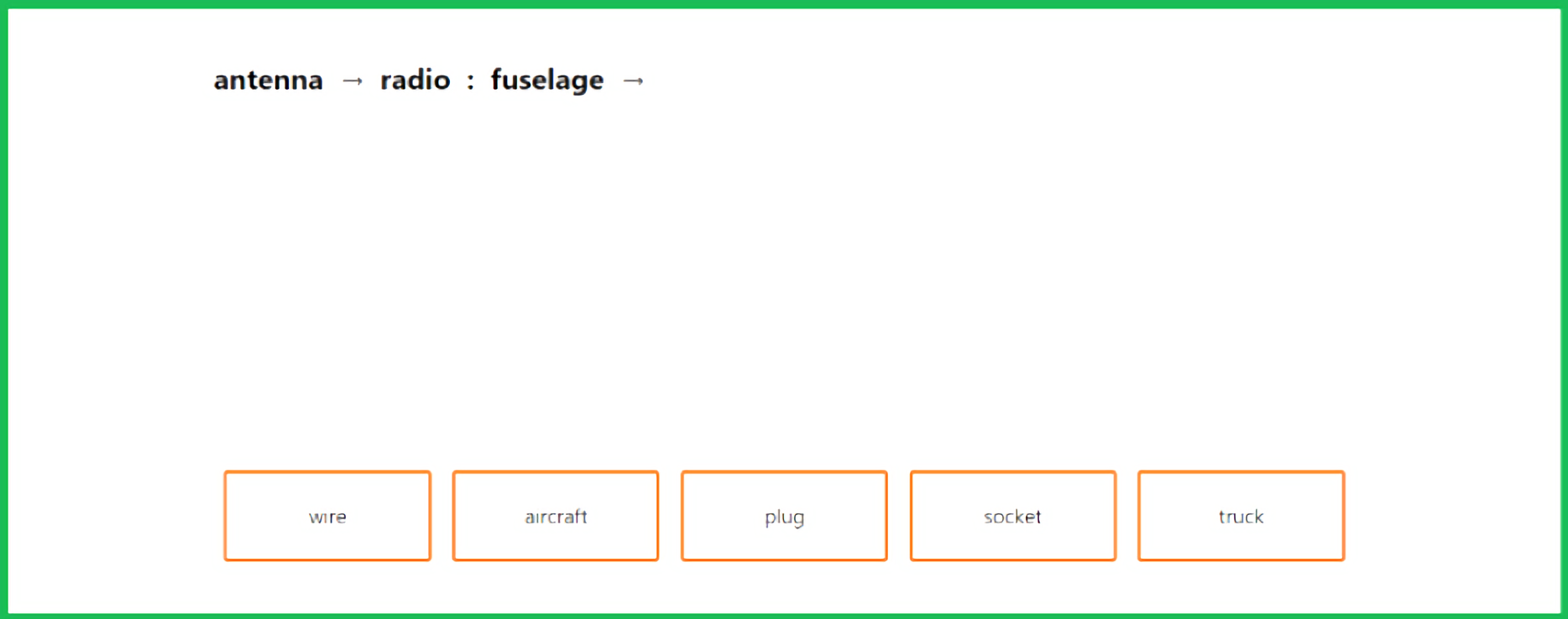
The reasoning here is split into two different facets. A student must first establish the differences and similarities between the first set and then establish which is the best fit for the second half of the question.
These matches are selected from a possibility of five different options, with the student looking to duplicate the relationship between the first pair in their choice of response. While background knowledge might play a part in determining the child’s responses, GL Assessment asserts that questions are written in order to instead focus on the identification of concepts and abstract links, rather than strict vocabulary knowledge.
Despite this, there are clear frameworks one can learn to identify consistent patterns within Verbal Analogies questions. You can learn more about these here.
Non-Verbal Reasoning (NVR) Battery
The next section to consider is the Non-Verbal Reasoning Battery, which, as the name might suggest, relates to modes of reasoning that are non-linguistic. What does this mean? Well, it means that all of the test exercises within the non-verbal battery do not use words as a means of gauging understanding and eliciting question responses, but rather they use geometric and figurative elements to visually depict problems for children to solve.
This means that the candidate does not need to use, nor possess, any prior knowledge of numbers or words in order to demonstrate their aptitude. Of course, this makes it particularly useful for students who have English as a second (or additional) language, as they needn’t be hampered by being unable to express themselves in the language of the test itself in this section.
So, what do the questions in this section actually look like in practice?
Figure Classification example question: In this type of question the candidate will be given three shapes (figures) to look at. All three will be similar in some way. For example, they may all be shaded in grey. The aim is to work out how they are the same and then to choose the most appropriate answer from the options given.
►This sample question is from CAT4 Level A – Practice Test 4:
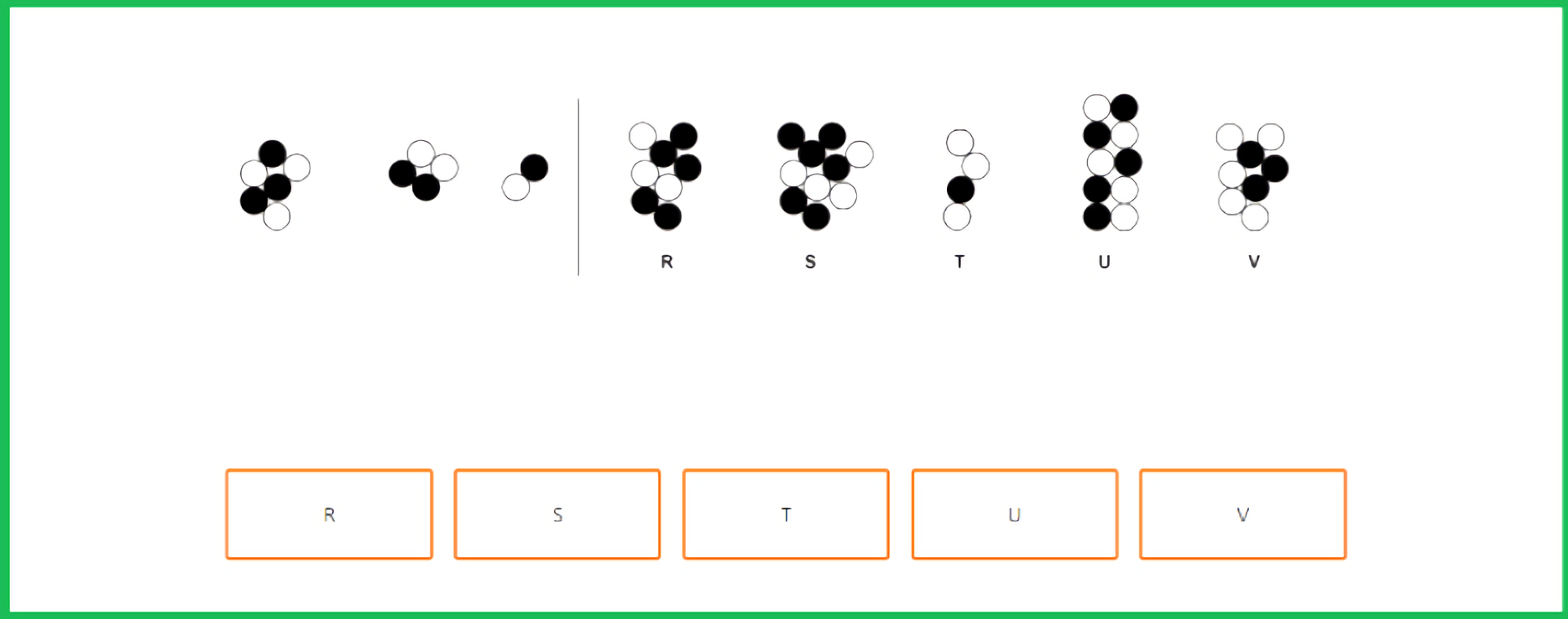
As you can see, the above example of the Figures Classification Test presents students with three separate figures. Candidates must identify a link or pattern in the presented figures and select another from a selection of five possible options.
This may sound familiar, as it is certainly a pattern which is repeated elsewhere in the CAT4 assessment, allowing a cross-comparison to show whether it might be language that is acting as a barrier to demonstrating language in school environments, among other factors. The Non-Verbal Reasoning battery allows students to demonstrate their aptitude in identifying the links, differences, similarities, and relationships between different figures, which can act as a basis for other kinds of aptitude across a wide array of subjects.
As well as Figure Classification, the other question type to be assessed in this battery is Figure Matrices.
Figure Matrices example question: In this type of question the candidate must find the missing shape (figure) that most logically completes the set. The candidate will be looking for a pattern in the shapes.
►This sample question is from CAT4 Level F – Practice Test 1:
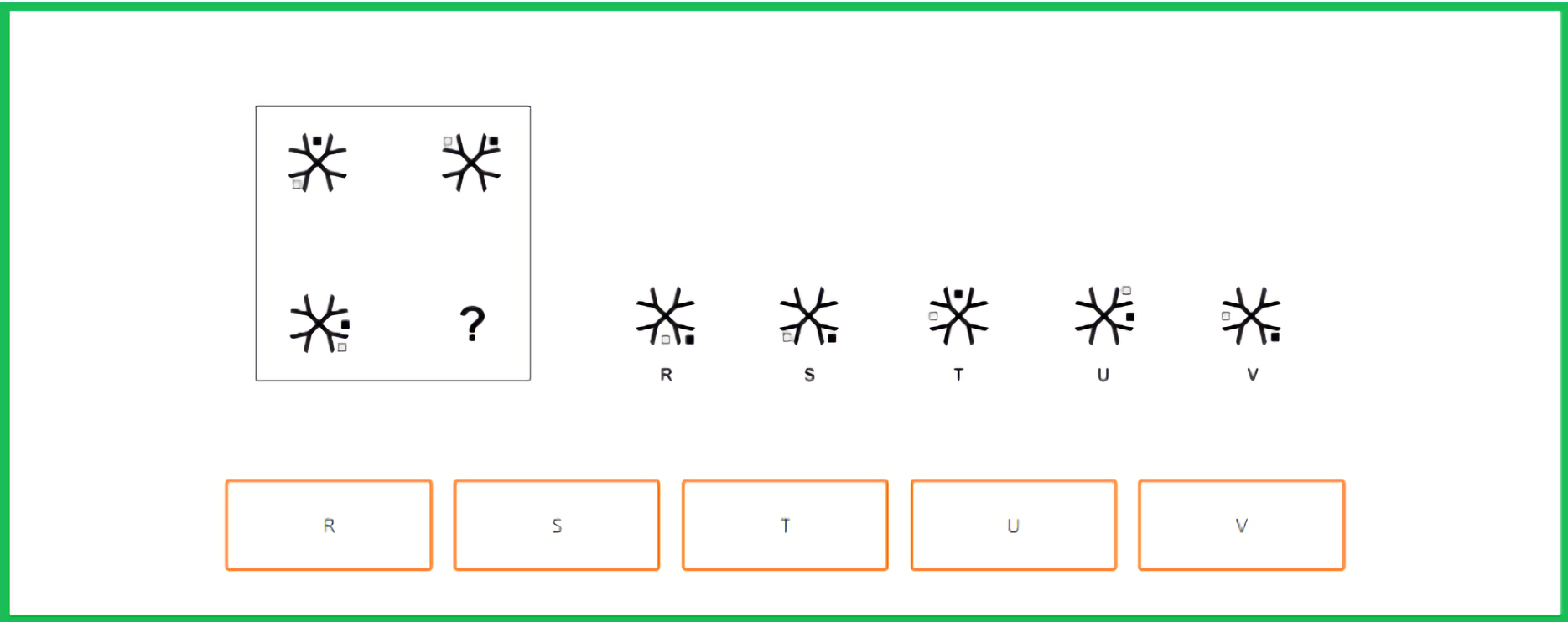
In these questions, students must select the correct option from five answer choices to complete the grid correctly. When dealing with questions like this, students should ideally have formed a mental checklist of things to look out for: shading, number, reflection, shape, size etc. The various options and possibilities within the Figure Matrices question type are all covered in great detail in this CAT4 Non-Verbal Reasoning Course.
Quantitative Reasoning (QR) Battery
One of the key modes of assessment in the Quantitative Reasoning (QR) battery is the Numbers Analogies test, not dissimilar to the Verbal Analogies test that is presented in the Verbal Reasoning (VR) battery.
In the Numbers Analogies test, students are presented with three pairs of numbers. Candidates must deduce the link between the numbers presented in the first two sets so that they can then choose the correct pair in the third example from a set of five total numbers, just like with the Verbal Analogies Test.
Not only does this test the same skills as the Verbal Analogies test, however, it also incorporates basic arithmetic and numerical skills in order for the students to be able to perceive the links between numbers. While some students may find it easy to establish the links between words, and therefore more easily choose the correct pairing in the Verbal Analogies test, they may not find it as easy when faced with numbers – and vice versa, of course.
The more flexible and creative ways that a candidate is able to deal with numbers, the more likely they are to be successful in the Numbers Analogies section of the Quantitative Reasoning battery.
Number Analogies example question: The candidate will see two pairs of numbers, linked in some way and then a single number of another pairing, which needs to be completed. It’s all about spotting a rule in the relationship between the numbers in the pair. The candidate may have to add, subtract, multiply or divide to spot the rule.
►This example question is from CAT4 Level B – Practice Test 3:
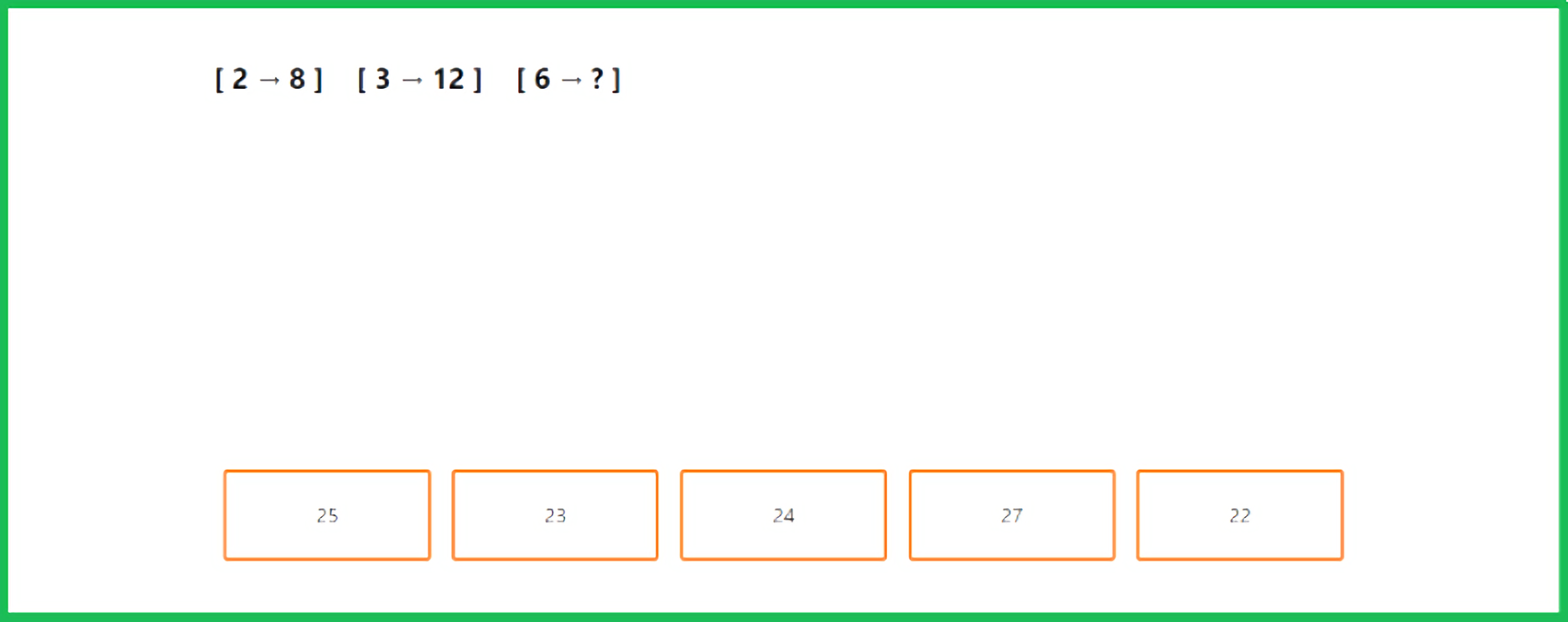
The other question type covered in the Quantitative Reasoning section of the CAT test is called Number Series. In these questions, students are shown a series of number and they must choose which one comes next from the answer options provided.
Number Series example question: The candidate will see a series of numbers and have to work out the rule/s used to arrange the order of the numbers and then decide which one comes next in the series.
►This Number Series example question is from CAT4 Level E – Practice Test 5:
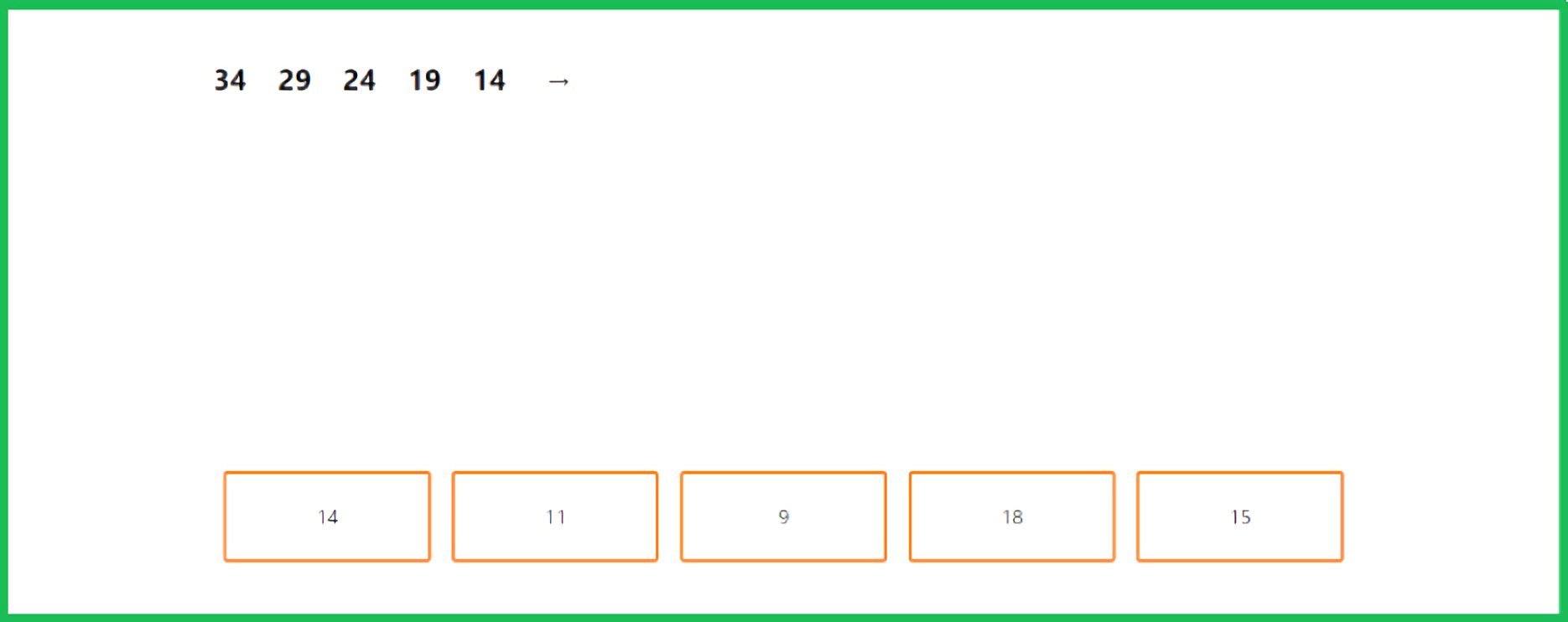
For both the Number Analogies and Number Series modules, there are clear patterns to look out for. To learn more about these patterns, check out this course.
Spatial Reasoning (SR) Battery
The final of our four batteries is the Spatial Reasoning battery, also called the Spatial Ability or Spatial Awareness battery.
In the Figure Analysis test, which forms a part of this battery, students are presented with an image of a piece of paper that has been repeatedly folded and then has had a hole punched through it. In this exercise, students must deduce what that piece of people will then look like once it has been subsequently unfolded. Similarly to the other exercises that make up the CAT4, candidates must choose their answer out of a total of five choices that are provided in the assessment.
The Spatial Reasoning battery, and the Figure Analysis test, may be one of the more obscure ways of testing a student’s abilities, and leave some parents wondering what exactly it assesses, and how? Well, this test exercise is designed to assess the ability to visualise and predict the outcomes of actions taken upon objects in relation to their physical shape and space.
Effectively, it tests whether a candidate is able to create a visualisation of what might be happening to each of the objects that they are presented with in the question. And, furthermore, whether they are then able to imagine what would happen if a series of different processes were undertaken upon that object. Once the student has a clear idea of what it is exactly they imagine that the end product looks like, they must then compare the results provided with their expectations, and find a match. In short, they must analyse the figures in order to establish the correct process and result correlation.
Figure Analysis example question: This is based on symmetry. The candidate will be shown a diagram, for example an image of a folded piece paper with holes punched into it, and the candidate must work out what it would look like when laid out flat and unfolded, and pick the appropriate answer.
►This example question is from CAT4 Level D – Practice Test 2:
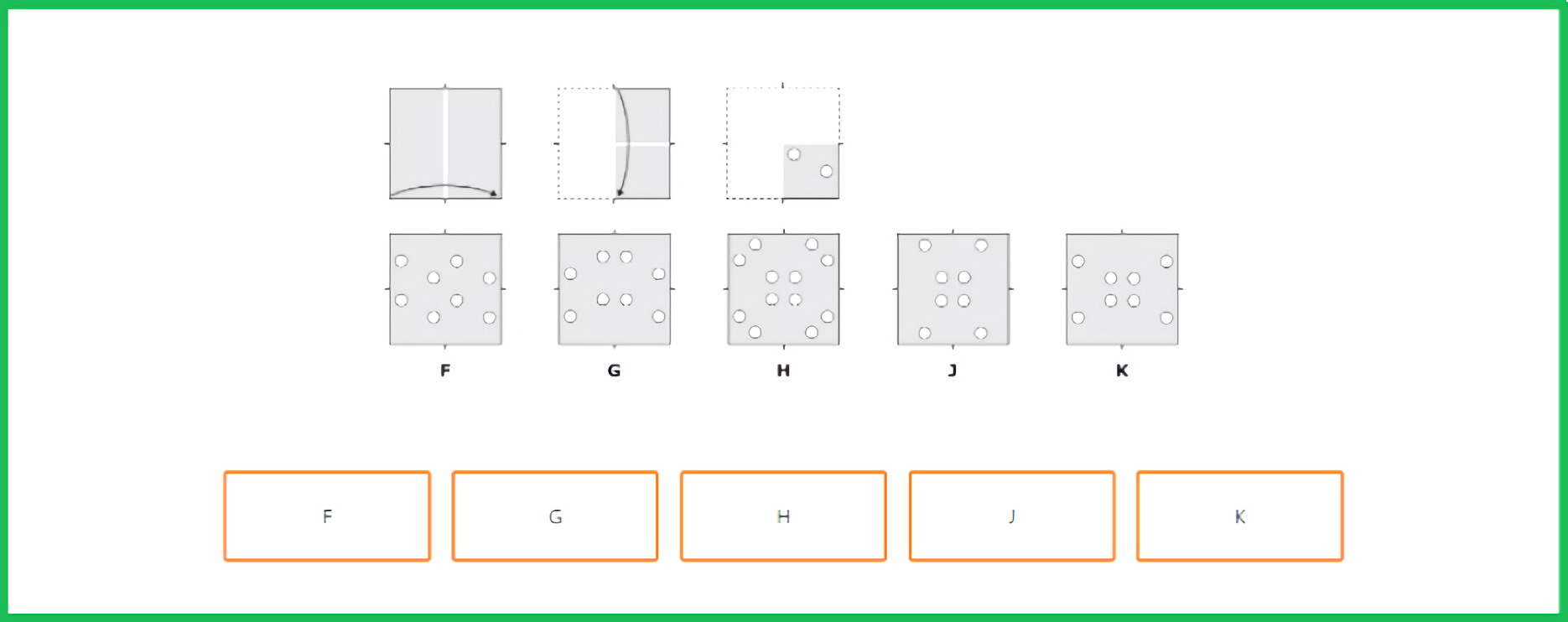
The second section of the Spatial Reasoning battery consists of the Figure Recognition test. In this exercise, students are presented with five complex geometric shapes. These shapes are line drawings, which contain multiple shapes combined to make one larger polygon. They are then given another ‘target’ shape, which must be able to fit into one of the other shapes in some way, using all of the sides provided. Students are required to successfully answer these questions by fitting a given shape into another, without any excess sides or mismatched sizes. The shape must not be rotated or reflected.
Figure Recognition example question: This is about recognising hidden shapes. Each question has a target shape. The target shape is hidden in one of the five multiple-choice answers and candidates must spot it to answer correctly. There is no requirement to turn or flip the shape to find it.
►This example question is from CAT4 Level C – Practice Test 2:

In essence, this exercise is testing the ability to retain complex and simple shapes in the memory, and accurately recreate lengths, shape, and angles, and compare them. Similarly to the Figure Analysis test, it is also testing the skill of Visualisation.
>> Read on to learn about the different CAT4 levels, as well as the style and timings of the exam.
What is the format of the CAT4?
We have already discussed that the CAT4 both comprises of four different batteries (Verbal Reasoning, Non-Verbal Reasoning, Quantitative Reasoning, and Spatial Reasoning) and that these abilities are tested across a range of three different 45 minute sections that make up a total assessment time of 2 hours and 15 minutes including breaks, instructions, practice questions etc. For Levels X and Y, there are four modules in total, one for each battery. For Levels A to G, there are eight modules in total, two for each battery. What are the different CAT4 Levels?
The main way in which the CAT4 levels are distinguished from one another is by age group, much like other assessments. While the CAT4 is still predominantly in use by secondary schools in order to assess its pupils’ abilities, in addition to as part of their administration of admissions assessments, these tests can be used to assess the academic potential of pupils as young as 6 and 7 years old.
There are seven levels of the CAT4, all with its own corresponding age group:
Year 2: Level X (6–7 years)
Year 3: Level Y (7–8)
Year 4: Level A (8–9)
Year 5: Level B (9–10)
Year 6: Level C (10–11)
Year 7: Level D (11–12)
Year 8: Level E (12–13)
Years 9 + 10: Level F (13–15)
Years 11+: Level G (15–17+)
LEVEL X & LEVEL Y
Comparatively to Levels A-G of the CAT4, Levels X and Y operate slightly differently to their other counterparts. Used in Years 2 and 3 (P3 and P4 in Scotland) these results are used in early-years Primary Education settings. For a wide variety of reasons, trying to assess aptitude at such young ages can be problematic and cause difficulties: mainly because children develop at such different rates to one another.
The CAT4 at Levels X & Y therefore are presented in the simplest possible format in an attempt to even the playing field for younger students and gain an accurate measurement of future potential growth and current aptitude. It is suggested that children at this age will require significant support.
The Level X & Y CAT4 assessments are structured as follows:
Part One:
- Figures (12 mins)
- Word (10 mins)
Part Two
- Numbers (10 mins)
- Shapes (11 mins)
Click here to learn more about CAT4 Level X Practice Tests.
Click here to learn more about CAT4 Level Y Practice Tests.
LEVELS A-G
The format and timings of the CAT4 Test for Levels A to G remain the same. The only variation is in the difficulty level, which increases with each level. As we have already explored in more detail, this assessment is split into four different skills batteries:
- Non-Verbal Reasoning
- Verbal Reasoning
- Quantitative Reasoning
- Spatial Reasoning
These are split across three different sections that must be completed in chronological order. As regards the types of questions that will be encountered at the level, for all levels A-G question types remain the same as those that we have previously explored.
Part One takes 20 minutes, and consists of 24 questions on Figure Classification and 24 questions on Figure Matrices. Therefore, 10 minutes are allocated to each type of question, so that’s an average of twenty five seconds for each question to be answered.
Part Two takes 26 minutes of test time (additional time for practice questions etc) and works through a series of questions on Verbal Classification, Verbal Analogies, and Number Analogies. The first lot of Verbal Classification questions amounts to a total of 24 questions to be completed in 8 minutes followed by 24 Verbal Analogies questions also to be completed in 8 minutes. This means students need to answer a question every 20 seconds on average to complete each module. The final module in Part 2 of the CAT4 test is Number Analogies, with 18 questions to be completed in 10 minutes.
Part Three of the CAT4 is also 26 minutes in length, with a total of 18 Number Series questions (8 minutes), 18 Figure Analysis questions (9 minutes) and 18 Figure Recognition questions (9 minutes).
What are the timings of the CAT4 Test?
In summary, the timings are as follows for CAT4 Levels X and Y:
Figures – 12 minutes
Words – 10 minutes
Numbers – 10 minutes
Shapes – 11 minutes
The timings are as follows for CAT4 Levels A – G:
Non-Verbal Reasoning
Figure Classification – 10 minutes
Figure Matrices – 10 minutes
Verbal Reasoning
Verbal Classification – 8 minutes
Verbal Analogies – 8 minutes
Quantitative Reasoning
Number Analogies – 10 minutes
Number Series – 8 minutes
Spatial Reasoning
Figure Analysis – 9 minutes
Figure Recognition – 9 minutes
How long does the CAT4 take?
The combined length of the modules is 72 minutes. However, the test takes longer to complete as there are instructions, sample questions and practice questions to deal with before each module begins. Furthermore, there can be short breaks between the modules. In total, the CAT4 test takes 2.5 hours to complete in one sitting.
How long should I spend on each section of the CAT4?
The breakdown of how long you have on average for each question in a section is as follows:
Non-Verbal Reasoning
Figure Classification – 25 seconds per question
Figure Matrices – 25 seconds per question
Verbal Reasoning
Verbal Classification – 20 seconds per question
Verbal Analogies – 20 seconds per question
Quantitative Reasoning
Number Analogies – 33 seconds per question
Number Series – 26 seconds per question
Spatial Reasoning
Figure Analysis – 30 seconds per question
Figure Recognition – 30 seconds per question
Why do schools use the CAT4?
There are three main reasons why a school uses the CAT4 test:
- To benchmark progress and identify potential weaker areas in a student’s developed ability
- To help make decisions on streaming candidates within a year group
- To assess potential candidates for entry into the school.
>> Further details on each of these reasons can be found below.
Which schools use the CAT4?
Both state schools and private schools use the CAT4.
Within state schools, it is mainly to help identify any weaknesses in a student’s ability. Many schools have their students take the test once per year so they can benchmark progress as pupils grow and develop.
A large number of independent/private schools also use the CAT4 for streaming purposes. Scoring well in the test may mean your child is placed in a higher ability set within their year group.
Many private schools also use the CAT4 test as part of their assessment process for entrance into the school. They may ask your child to take the test as part of their entrance exams or they may request the latest CAT4 report from your child’s current school. If your child is taking the 11+ exam, the CAT4 test they take at the beginning of Year 6 is especially important.
How can I prepare for the CAT4?
If you have a child or know a student that has an upcoming CAT4 assessment planned, whether as part of an admissions process or a wider educational program, you may be wondering how best to prepare them to achieve success in their tests. As with any other test, the idea of studying or preparing for an examination to achieve a high score is natural.
There is no doubt that familiarity with the format, question types and timings of the CAT4 test can help your child improve their score and feel confident going into their assessment.
That’s why we’ve created a series of highly accurate practice tests for all levels of the CAT4 exam from Level X all the way up to Level G. You can view the full range here.
What do CAT4 Test Scores mean?
Depending on the rules that the school has in place, once you or your child has completed a CAT4 assessment, you may then be able to access the results of this assessment, and should be able to discuss the results of the CAT4 with your child’s teacher. It may be the case that you are only provided with areas for improvement and strengths as an outline from your educational institution. However, the full results themselves, received by the educational institution on each student, can be a little more difficult to make sense of, provided that you can get your hands on them.
The CAT4 is a digital aptitude test, meaning that scores for the assessment’s results can be generated very quickly once the test has been completed. These raw scores are out of a total of 168 as this is the total number of questions in the test for Levels A upwards.. Remember, however, that the CAT4 is a standardised test that takes into account scores from students across the country, standardised across up to a total of 250,000 students.
Students are then given three standardised scores according to their raw score mark:
- National Percentile Rank (NPR)
– This score is a summation of where they sit in relation to their peers in the standardised score tables across the country. This score is given as a percentage, signifying the proportion of students that they scored higher/lower than. An NPR score of 80% would mean that the candidate scored higher than 80% of students, and lower than only 20%.
- Standard Age Scores (SAS)
– These scores act as a benchmark by which a student’s score can be compared against an average. This is always 100 with a standard deviation of 2. This is often seen as the equivalent of the ‘pass/fail’ boundary of the CAT4, but it is important to remember that this is not the case. Identifying the reasons for a pupil sitting below the average score in relation to their peer group is an important part of the CAT4, that will help better support the student going forward.
- Stanines (ST)
– This score is a combination of both of the above scores in order to demonstrate to educators the performance of individual students and their aptitude in relation to their peers.
The Stanine Scale operates on the basis of numbers 1-9, with 1 being ‘Very Low’ and 9 being ‘Very High’, much like the new GCSE system of awarding grades. In terms of Percentiles (NPR) and SAS (Peer Average) scores, these correspond as follows:
- A Stanine Rank of 9 accounts for just 4% of cases, with a NPR of 97% or higher, and a SAS Score of 127 or higher.
- A Stanine Rank of 8 accounts for 8% of cases, with a NPR of 90-96%, and a SAS Score of 119-126.
- A Stanine Rank of 7 accounts for 12% of cases, with a NPR of 78-89% and a SAS Score of 112-118.
- A Stanine Rank of 6 accounts for 17% of cases, with a NPR of 59-77% and a SAS Score of 104-111.
- A Stanine Rank of 5 accounts for 20% of cases, with a NPR of 41-58% and a SAS Score of 97-103.
- A Stanine Rank of 4 accounts for 17% of cases, with a NPR of 23-40% and a SAS Score of 89-96.
- A Stanine Rank of 3 accounts for 12% of cases, with a NPR of 12-22% and a SAS Score of 82-88.
- A Stanine Rank of 2 accounts for 7% of cases, with a NPR of 5-11% and a SAS Score of 74-81.
- A Stanine Rank of 1 accounts for 4% of cases, with a NPR of 4 or less and a SAS Score of 73 or lower.
If you need help understanding and interpreting your child’s CAT4 scores, either from the actual test or from one of our practice tests, feel free to contact us here. We’d be happy to provide further insights into what the scores mean and what steps you may or may not wish to take next.
Frequently Asked Questions (FAQs) about the CAT4 Assessment
-
Is Cat 4 an IQ test?
The CAT4 is an aptitude test, rather than an IQ test. This may seem like an academic difference, but in fact there are important distinctions to be made between the two. While an IQ Test is essentially a measure of a person’s ‘intelligence’ or Intelligence Quotient (IQ), an aptitude test is a way to determine how capable a person is of applying that knowledge in different situations, often creatively or imaginatively. Aptitude tests can perhaps be seen as a different way of measuring intelligence that doesn’t strictly rely on traditional notions of IQ.
-
What is a good CAT4 score? What is a high CAT4 score?
The average standardised (SAS) score for the CAT4 test is 100. So a score above this in each battery means your child is above average. A standardised score of 127 places your child into the top 5% of students nationwide. Therefore, one can state with a reasonable degree of confidence that 127+ is a high CAT4 score.
-
What do Cat 4 results mean?
There are several ways of interpreting CAT4 results according to which of the standardised scores you are using: the NPR, SAS, or Stanine. You can find out more about how to interpret the full results here.
-
Is GL and CAT4 same?
CAT4 is a specific aptitude-based assessment designed for students from Years 2 to 13. GL Assessment, on the other hand, is the company that creates the CAT4 test. So the CAT4 is the test and GL Assessment is the test publsiher.
-
Is CAT4 CEM or GL?
The CAT4 assessments are designed and published by GL Assessment. CEM is a different publisher with their own set of assessments. One of their popular online tests that is used for school entrance assessments is known as CEM Select.
-
What is a good CAT score in Year 7?
In Year 7, a good score can be defined as a standardised score over 100, which is the average score. A very good CAT4 score would be 127+, which places the student in the top 5% nationwide. The definition of what a ‘good’ score constitutes can of course vary depending on what your aims are. If you are targeting a highly competitive school for 11+ entry, you will want to go for as high a score as possible.
-
What is CAT4 GL?
CAT4 is an aptitude assessment that is developed by GL, you can find out more about it here.
-
What is the CAT4 report?
The CAT4 report is provided to the school which has administered the CAT4 test, and is not usually available for parents to see. You can find out more about how these scores are presented for individuals here.
-
What are CAT4 levels? What are the levels in CAT4?
The different levels of the CAT4 depend on when the test is administered for pupils, and their age. You can find out more about the individual structure of each of these levels and what age boundaries they are administered at here.
-
What is level C in the CAT4 test?
The CAT Levels are administered according to age, rather than ability, with the CAT4 Level C being targeted at Year 6 pupils.
-
What is CAT4 level B?
The CAT Levels are administered according to age, rather than ability, with the CAT4 Level B being targeted at Year 5 pupils.
-
What is level D in CAT4?
The CAT Levels are administered according to age, rather than ability, with the CAT4 Level D being targeted at Year 7 pupils.
-
What is CAT4 level F?
The CAT Levels are administered according to age, rather than ability, with the CAT4 Level F being targeted at Year 9/10 pupils.
-
How long is the CAT4 test?
The length of the CAT4 test can vary from level to level, depending on the age of the student that is sitting the test. You can find out more information about the timings and structure of each of the levels here.
-
What is a CAT test in Year 12?
The CAT4, when administered in Year 12, acts as an indicator for possible future careers aptitude and can inform students as to their next steps into the professional world after their A-Levels or vocational Higher Education ends. Students in Year 12 will take the Level G CAT4 test.
-
What are Year 7 CAT tests?
You can find out more about the purpose of the CAT4 test in Year 7 here, with the test usually being used at this age being Level D.
-
Is CAT4 adaptive?
The CAT4 is not an adaptive assessment. That means the questions are fixed and the same for each student. It also means you can skip questions in the test and come back to them later.
-
Can I change my answers in the CAT4?
Yes you can go back and forth within each module and change your answers. However, once the module is complete, you will no longer be able to make any changes.
-
Can my CAT score be improved? How do I maximise my CATs score?
Yes definitely. As with anything in life, a little practice and preparation can go a long way. The format of the CAT4 test is always the same so getting familiar with this layout and the eight types of questions you can expect to see will make a big difference. You can learn more about the key facts about the CAT4 test here.
-
Are CAT scores reliable?
CAT scores can act as reliable indicators of future performance and current potential. However, you should not be disheartened if your child has not scored as highly as you had hoped. With a little preparation, it’s amazing how much improvement students can make in the CAT4 assessment,
-
What questions are on a cognitive test?
The questions in the Cognitive Abilities Test are divided into four sections: Verbal Reasoning, Quantitative Reasoning, Spatial Reasoning and Non-Verbal Reasoning.
-
What are the batteries in the CAT4 test?
Batteries is a synonym for sections in this case. There are four main batteries or sections in the CAT4 test. They are Verbal Reasoning, Non-Verbal Reasoning, Spatial Reasoning and Quantitative Reasoning.
-
What is the highest CAT score you can get?
he highest possible score that you could receive on the CAT4 is if you were to answer all of the questions correctly, which would be a raw score of 168 as there are 168 questions in the test. However, getting all the questions correct is extremely rare. The highest possible standardised score is 140+ and you certainly don’t need to get all the questions correct to achieve this score.. A mark of 140+ places the student in the top 1% of all test takers.
CAT4 Practice Tests and Courses
Practice Tests
Our CAT4 Practice tests cover these question types in timed sections and provide great practice for those taking any form of the Cognitive Ability Test. You can learn more about our highly accurate online CAT4 practice tests by clicking on the links below. These CAT4 Practice Tests are available to take online immediately after purchase. Each module is marked automatically and is then available for review with answers and explanations provided for every question. We also provide comparative ranking statistics on a per module basis so you can quickly identify your child’s strengths and weaknesses.
CAT4 Level X (7+)
CAT4 – Level X – Practice Test 1
CAT4 – Level X – Practice Test 2
CAT4 – Level X – Practice Test 3
CAT4 – Level X – Practice Test 4
CAT4 – Level X – Practice Test 5
CAT4 Level X (7+) – Save 25%
CAT4 – Level X – Practice Tests Bundle
CAT4 Level Y (8+)
CAT4 – Level Y – Practice Test 1
CAT4 – Level Y – Practice Test 2
CAT4 – Level Y – Practice Test 3
CAT4 – Level Y – Practice Test 4
CAT4 – Level Y – Practice Test 5
CAT4 Level Y (8+) – Save 25%
CAT4 – Level Y – Practice Tests Bundle
CAT4 Level A (9+)
CAT4 – Level A – Practice Test 1
CAT4 – Level A – Practice Test 2
CAT4 – Level A – Practice Test 3
CAT4 – Level A – Practice Test 4
CAT4 – Level A – Practice Test 5
CAT4 Level A (9+) – Save 25%
CAT4 – Level A – Practice Tests Bundle
CAT4 Level B (10+)
CAT4 – Level B – Practice Test 1
CAT4 – Level B – Practice Test 2
CAT4 – Level B – Practice Test 3
CAT4 – Level B – Practice Test 4
CAT4 – Level B – Practice Test 5
CAT4 Level B (10+) – Save 25%
CAT4 – Level B – Practice Tests Bundle
CAT4 Level C (11+)
CAT4 – Level C – Practice Test 1
CAT4 – Level C – Practice Test 2
CAT4 – Level C – Practice Test 3
CAT4 – Level C – Practice Test 4
CAT4 – Level C – Practice Test 5
CAT4 Level C (11+) – Save 25%
CAT4 – Level C – Practice Tests Bundle
CAT4 Level D (12+)
CAT4 – Level D – Practice Test 1
CAT4 – Level D – Practice Test 2
CAT4 – Level D – Practice Test 3
CAT4 – Level D – Practice Test 4
CAT4 – Level D – Practice Test 5
CAT4 Level D (12+) – Save 25%
CAT4 – Level D – Practice Tests Bundle
CAT4 Level E (13+)
CAT4 – Level E – Practice Test 1
CAT4 – Level E – Practice Test 2
CAT4 – Level E – Practice Test 3
CAT4 – Level E – Practice Test 4
CAT4 – Level E – Practice Test 5
CAT4 Level E (13+) – Save 25%
CAT4 – Level E – Practice Tests Bundle
CAT4 Level F (14+ & 15+)
CAT4 – Level F – Practice Test 1
CAT4 – Level F – Practice Test 2
CAT4 – Level F – Practice Test 3
CAT4 – Level F – Practice Test 4
CAT4 – Level F – Practice Test 5
CAT4 Level F (14+ & 15+) – Save 25%
CAT4 – Level F – Practice Tests Bundle
CAT4 Level F (16+ & 17+)
CAT4 – Level G – Practice Test 1
CAT4 – Level G – Practice Test 2
CAT4 – Level G – Practice Test 3
CAT4 – Level G – Practice Test 4
CAT4 – Level G – Practice Test 5
CAT4 Level F (16+ & 17+) – Save 25%
CAT4 – Level G – Practice Tests Bundle
Video Courses
The following online video courses cover everything your child needs to know for each section of the CAT4 assessment. Each course consists of a series of lessons that go through each question type in great detail, providing step-by-step explanations and techniques to help your child recognise the underlying patterns to look out for. They cover every possible question type that could come up in the CAT4 test.
CAT4 Quantitative Reasoning Course
CAT4 Non-Verbal Reasoning Course
CAT4 Video Courses Bundle – Save 25%
Special Offer!
Please note that Pretest Plus is an independent publisher of practice tests and not affiliated with or endorsed by any other test publisher.
Related posts:
Year 7 CATs: Everything Parents Need to Know
Bookmark this page? Pop your email into the box below to receive a link to this article so you can easily refer back to it later.






